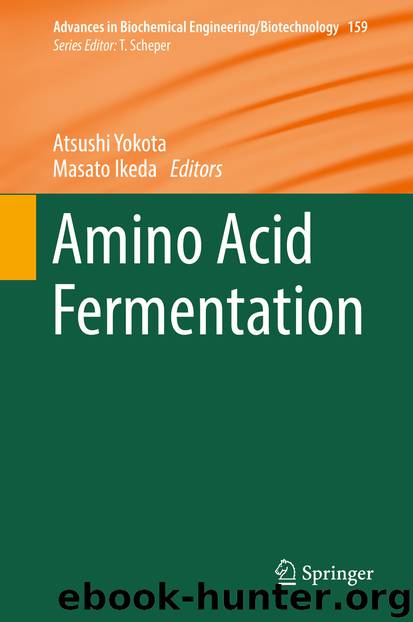Amino Acid Fermentation by Atsushi Yokota & Masato Ikeda

Author:Atsushi Yokota & Masato Ikeda
Language: eng
Format: epub
Publisher: Springer Japan, Tokyo
MetA exists physiologically as a homodimer [41, 47]. For B. cereus, the 16 N-terminal residues are disordered, and structural data has not been provided by X-ray crystallography. Strikingly, residues 17–33 are well defined despite a long extended structure away from the core of the enzyme. This region together with the unknown structure of the first 16 amino acids is important for dimerization and thermostability. Unlike MetA of B. cereus, MetA of T. maritima shows ordered structure in residues 1–16 and 17–26, and the regions interact with different residues on the surface (Fig. 2b). These differences may prevent MetA of T. maritima from forming an inclusion body at high temperatures [43], which has been an intriguing feature of MetA of E. coli [48–51]. However, the effect of such differences and the role of the N-terminal need to be further studied.
It should be noted that MetA is tightly regulated by feedback inhibition occurring at the dimerization interface which includes the N- and C-terminal regions [36, 37]. Major feedback inhibitors are d,l-methionine and SAM. A large number of point mutations have been reported to decrease the feedback inhibition. Usuda and Kurahashi [52] showed that mutations in Arg27, Ile296, and Pro298 lead to reduced feedback regulations in MetA of E. coli. Bestel-corre et al. [53] expanded the effective region for feedback-insensitivity to residues 24–30, 58–65, and 292–298. Independently, Leonhartsberger et al. [54] also found feedback-resistant mutations in the Asp in the AspGlyXaaXaaXaaThrGlyAlaPro sequence of residues between 90 and 115 and in the Tyr in the TyrGlnXaaThrPro sequence of residues between 285 and 310. Both residues are involved in interactions near the N- and C-terminal regions. Other known mutation sites in MetA of E. coli [55] are Asn290 and Tyr291, which are near residues discussed above. Asn79, Glu114, Phe140, Lys163, Phe222, and Ala275 do not seem to have particular interactions with N- or C-terminal regions but show feedback resistance [55]. Residues for mutations listed above are displayed in Fig. S2 in the supporting information.
In addition to N-terminal residues, surface residues of MetA are important regarding thermostability and acid tolerance [56]. Perturbations of electrostatics or rigidifying flexibility of surface residues are a useful strategy in enzyme engineering [57, 58]. Mutations increasing the stability of enzymes, thus leading to better cell growth, have been identified using random-mutagenesis (Ser61Thr, Glu213Val, Ile229Thr, Asn267Asp, and Asn271Lys) [56] (Fig. S3). Each residue is solvent exposed and capable of forming noncovalent interactions with nearby residues. Detailed investigation of the structure–function relationship of MetA is expected to help accelerate yields of methionine during fermentation by overcoming sensitivity to temperatures and negative feedback inhibition by end products.
There have been studies showing some MetAs are able to function as an acetyltransferase using acetyl-CoA as a substrate [8, 40, 43]. A single residue at position 111 in MetA of B. cereus determines the preference between succinyl-CoA and acetyl-CoA. When Gly is present at 111, the active site exclusively accommodates succinyl-CoA. However, Glu at 111 enables MetA to use acetyl-CoA and inhibits the succinyl-CoA binding by electrostatic repulsion with Glu111.
Download
This site does not store any files on its server. We only index and link to content provided by other sites. Please contact the content providers to delete copyright contents if any and email us, we'll remove relevant links or contents immediately.
| Cell Biology | Developmental Biology |
| Entomology | Marine Biology |
| Microbiology | Molecular Biology |
| Biostatistics |
Sapiens: A Brief History of Humankind by Yuval Noah Harari(14252)
The Tidewater Tales by John Barth(12608)
Mastermind: How to Think Like Sherlock Holmes by Maria Konnikova(7227)
Do No Harm Stories of Life, Death and Brain Surgery by Henry Marsh(6890)
The Thirst by Nesbo Jo(6826)
Why We Sleep: Unlocking the Power of Sleep and Dreams by Matthew Walker(6618)
Life 3.0: Being Human in the Age of Artificial Intelligence by Tegmark Max(5474)
Sapiens by Yuval Noah Harari(5294)
The Longevity Diet by Valter Longo(5019)
The Body: A Guide for Occupants by Bill Bryson(4974)
The Rules Do Not Apply by Ariel Levy(4861)
The Immortal Life of Henrietta Lacks by Rebecca Skloot(4525)
Animal Frequency by Melissa Alvarez(4395)
Why We Sleep by Matthew Walker(4360)
The Hacking of the American Mind by Robert H. Lustig(4318)
Yoga Anatomy by Kaminoff Leslie(4305)
All Creatures Great and Small by James Herriot(4232)
Double Down (Diary of a Wimpy Kid Book 11) by Jeff Kinney(4207)
Barron's AP Biology by Goldberg M.S. Deborah T(4097)
